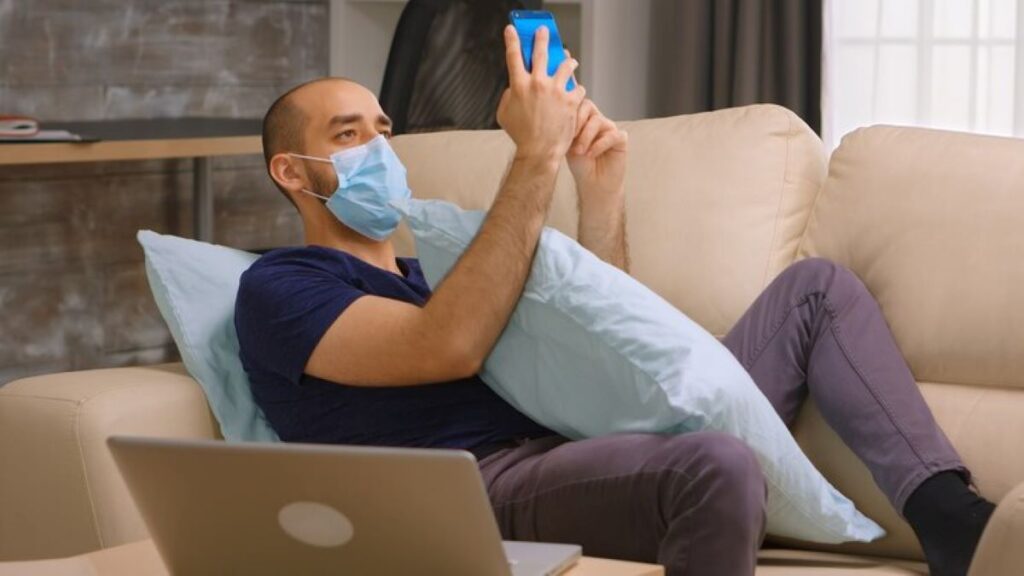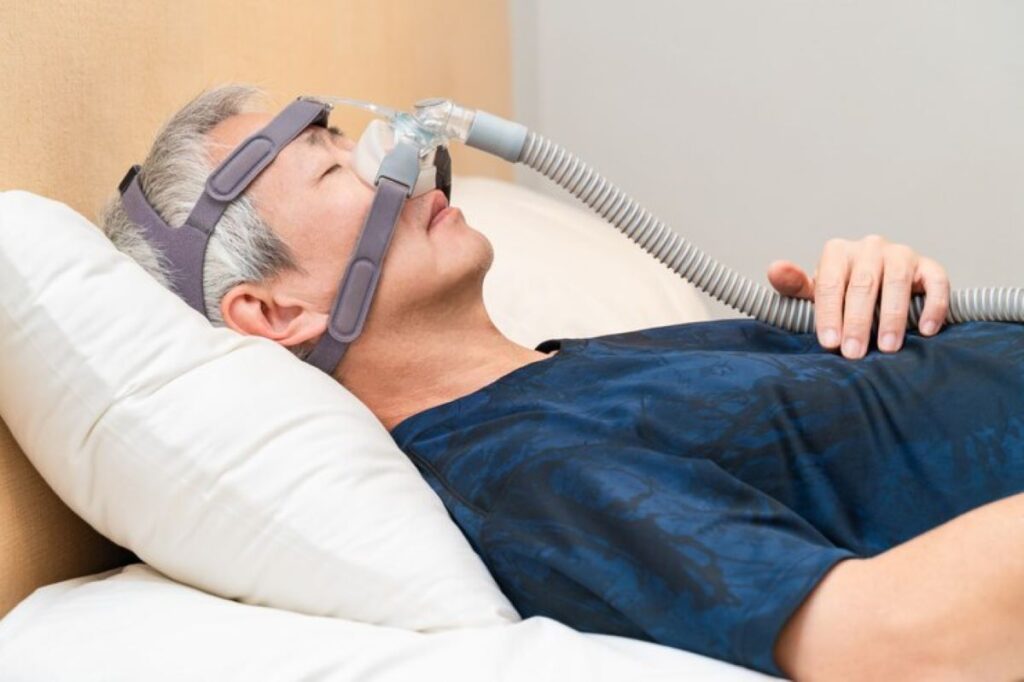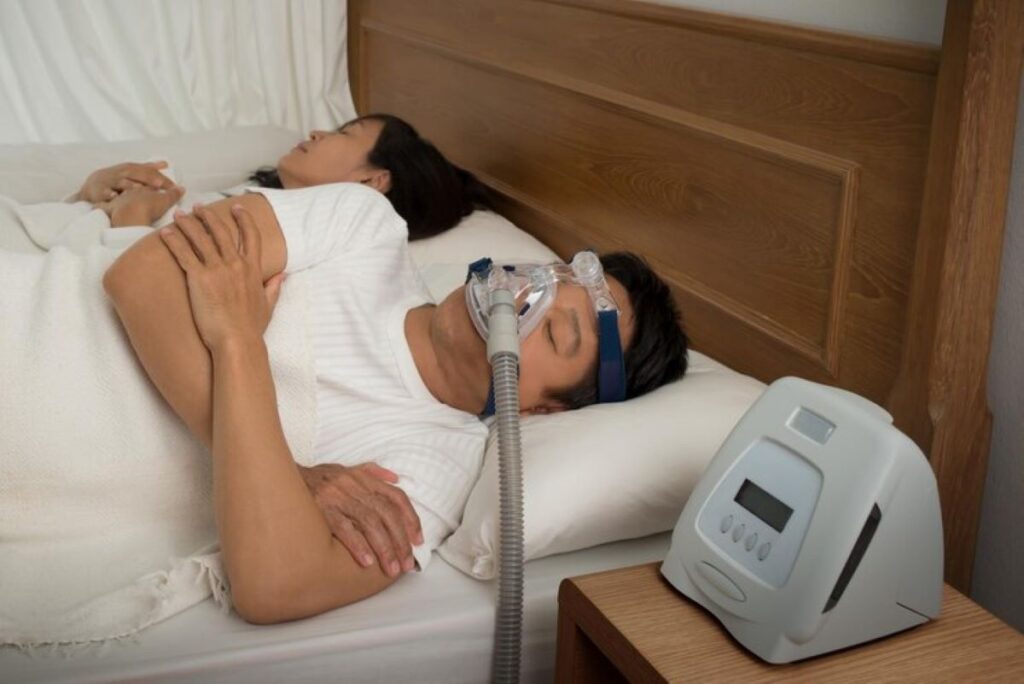What is a CPAP Machine and How Does it Help with Sleep Apnea?
A CPAP machine delivers continuous positive airway pressure through a mask to keep your airways open during sleep, making it the gold standard treatment for obstructive sleep apnea. The device prevents the repeated breathing pauses that characterise OSA by maintaining steady airflow throughout the night.
Obstructive sleep apnea treatment works by creating enough air pressure to stop your throat muscles from collapsing whilst you sleep. This constant pressure acts as an invisible splint, ensuring oxygen flows freely to your lungs without interruption. The result is deeper, more restorative sleep and elimination of the dangerous oxygen drops that damage your cardiovascular system.
Selecting the right sleep apnea machine directly impacts your therapy success. A poorly chosen device can lead to discomfort, mask leaks, and eventual abandonment of treatment. The ideal sleep apnea machine balances effective relief with features that match your breathing patterns, sleeping position, and lifestyle needs. Proper selection means you’re more likely to use the device consistently, which is essential for managing OSA symptoms and reducing serious health risks like stroke and heart disease.
What Types of CPAP Machines Are Available?
There are two main types of CPAP machines designed to meet different therapy needs:
- Fixed pressure CPAP machines: These devices deliver a single, constant air pressure throughout the night.
- Auto-adjusting CPAP (Auto-CPAP) devices: These machines continuously monitor breathing patterns and adjust pressure levels in real-time.
Fixed Pressure CPAP Machines
Fixed pressure CPAP machines maintain the prescribed pressure setting determined during your sleep study. These devices work well for patients with consistent breathing patterns and stable apnea severity. They’re typically more affordable and straightforward to operate.
Auto-CPAP Machines
Auto-CPAP machines offer personalised pressure by responding to changes in your breathing throughout different sleep stages, body positions, and even seasonal variations affecting nasal congestion. The device increases pressure when detecting apnea events and reduces it during stable breathing periods.
Importance of Machine Type
Machine type directly influences therapy success. Auto-CPAP models reduce the average pressure exposure, potentially improving comfort for new users or those sensitive to high pressure. Patients who sleep in multiple positions or experience pressure needs that vary between REM and non-REM sleep often benefit most from automatic adjustment capabilities.
Moreover, understanding the specific characteristics of each machine type can help in making an informed decision about which one would be most effective for your individual therapy needs. For instance, research indicates that the choice of CPAP machine can significantly affect patient compliance and overall treatment success.
How Do Mask Fit and Type Affect Sleep Apnea Therapy?
Choosing the right mask is crucial for successful sleep apnea therapy. It directly impacts how comfortable you feel during the night and how effective the treatment is.
Understanding Different Types of Masks
There are three main types of masks used in sleep apnea therapy:
- Nasal Pillows: These masks have soft, flexible inserts that fit directly into your nostrils. They’re great for people who need lower pressure settings or have facial hair that makes it difficult to use traditional masks.
- Nasal Masks: These masks cover your entire nose and are ideal for active sleepers who tend to move around during the night. They provide a secure seal while allowing natural airflow.
- Full Face Masks: As the name suggests, these masks cover both your nose and mouth. They’re designed for mouth breathers or individuals requiring higher pressure settings.
The Importance of Proper Fit
Regardless of the type of mask you choose, comfort is heavily reliant on achieving the right fit. Here are some common issues associated with poor mask fit:
- Too Tight: If your mask is overly tight, it can cause skin irritation and leave pressure marks on your face.
- Too Loose: On the other hand, if your mask is too loose, it can lead to air leaks which reduce the effectiveness of therapy.
The Consequences of Poor Mask Fit
When your mask doesn’t fit properly, it can trigger a series of problems:
- Air leaks may force your eyes open during sleep, disrupting its quality.
- Inadequate pressure delivery from leaks fails to keep your airways open.
- Dry mouth develops when leaks force you to breathe through your mouth instead of nose.
- Nasal congestion worsens from improper airflow distribution caused by leaks.
Professional Fitting Sessions
To ensure you find the correct size and style for your mask, consider scheduling professional fitting sessions. During these sessions, experts will test the seal integrity across different sleeping positions before finalising a specific type of mask for you.

What Comfort Features Should Users Look For in a CPAP Machine?
Ramp Feature
The ramp feature gradually increases air pressure from a lower starting point to the prescribed level over 5-45 minutes, allowing users to fall asleep before reaching full therapeutic pressure. This addresses one of the most common complaints about CPAP therapy: the difficulty of falling asleep with immediate high pressure.
Heated Humidification and Heated Tubing
Heated humidification and heated tubing work together to prevent the dryness and irritation that often discourage CPAP use. The humidifier adds moisture to the pressurised air, whilst heated tubing maintains consistent temperature throughout delivery, eliminating condensation (commonly called “rainout”) that can wake users with cold water droplets on their face.
Quiet Operation
Quiet operation has become standard in modern machines, with most operating below 26-30 decibels—quieter than a whisper. This benefits both users and bed partners, removing the disruptive noise that older models produced.
SmartStart Technology
SmartStart technology detects when users begin breathing into the mask and automatically initiates airflow, eliminating the need to manually press buttons. The machine also stops airflow when the mask is removed, streamlining the therapy experience for those learning how to choose the right CPAP machine for sleep apnea relief.
See Also : Top 5 Reasons to Buy CPAP Machines Online Instead of In-Store
How Important Is Data Connectivity in Choosing a CPAP Machine?
Wireless connectivity transforms modern CPAP machines into smart health monitoring devices that track and transmit your sleep data automatically. Machines with built-in cellular or Bluetooth capabilities upload nightly usage patterns, leak rates, and apnea events directly to secure cloud platforms without requiring manual intervention.
Sharing sleep data with healthcare providers enables precise therapy adjustments based on objective evidence rather than subjective reporting. Your sleep specialist can review detailed metrics remotely, identifying patterns that indicate whether your pressure settings need modification or if mask fit issues are compromising treatment effectiveness.
Therapy effectiveness tracking through dedicated smartphone apps gives you real-time insights into:
- Nightly usage hours and consistency
- Apnea-Hypopnea Index (AHI) scores showing breathing disruption frequency
- Mask seal quality and leak detection
- Progress trends over weeks and months
These apps often include educational resources, troubleshooting guides, and achievement milestones that motivate consistent CPAP use. The immediate feedback helps you understand how lifestyle factors—sleep position, alcohol consumption, or congestion—affect your sleep data monitoring results, empowering you to make informed adjustments that improve therapy outcomes.
Are There Special Considerations for Specific User Groups?
Do certain groups need specialized CPAP machines? Yes—women’s CPAP machines and travel CPAP machines address unique physiological and lifestyle requirements that standard devices may not accommodate.
Women’s CPAP Machines
Women often experience sleep apnoea differently than men, with episodes occurring primarily during REM sleep and requiring lower pressure settings. Machines designed for women incorporate algorithms that respond to these distinct breathing patterns, delivering gentler pressure adjustments that reduce discomfort whilst maintaining therapeutic effectiveness. The ResMed AirSense 10 AutoSet for Her exemplifies this approach with its female-specific algorithm.
Travel CPAP Machines
Frequent travellers benefit from travel CPAP machines engineered for portability without sacrificing performance. These devices typically weigh under 300 grams and measure less than 15 centimetres in length, fitting easily into carry-on luggage. Key features include:
- Battery compatibility for camping or international travel
- Universal voltage adapters (100-240V)
- Compact carrying cases with compartments for masks and accessories
- FAA approval for in-flight use
The Transcend and Z2 models represent popular travel options, offering full therapy capabilities in remarkably small packages.
How Can Users Adapt to Using a CPAP Machine Effectively?
Most users need 2-4 weeks to several months to fully adjust to CPAP therapy, with the adaptation period varying based on individual comfort levels and machine settings. The body requires time to become accustomed to breathing with continuous air pressure during sleep.
Starting with short daytime sessions of 15-30 minutes helps users familiarise themselves with the mask and airflow sensation without the pressure of falling asleep. Wearing the mask while watching television or reading creates positive associations before attempting overnight use.
Building up gradually improves therapy compliance:
- Week 1-2: Wear the mask during relaxation activities and naps
- Week 3-4: Use for the first few hours of sleep, then remove if uncomfortable
- Week 5+: Aim for full-night usage of at least 4 hours minimum
The ramp feature proves particularly valuable during the adaptation period, allowing users to fall asleep at lower pressures before the machine increases to therapeutic levels. Patience during this adjustment phase directly impacts long-term success with How to Choose the Right CPAP Machine for Sleep Apnea Relief, as proper adaptation ensures consistent nightly use.
What Are Common Issues with CPAP Machines and How Can They Be Resolved?
Troubleshooting Mask Leaks
Start by checking the tension of your straps to troubleshoot mask leaks—overtightening often worsens leaks rather than fixing them. A properly fitted mask should rest gently against your face without leaving deep marks. If leaks persist, you may need to switch to a different mask style (from nasal to nasal pillows, for example) for a better seal.
Relieving Nasal Congestion and Dry Mouth
Adjusting the humidification settings on your CPAP machine can help relieve nasal congestion and dry mouth. Increasing the heat level on your humidifier adds moisture to the air, preventing irritation. Using heated tubing ensures consistent humidity throughout the delivery process, reducing condensation and dryness. If you’re a mouth breather experiencing persistent dry mouth, consider switching to a full face mask.
Managing Claustrophobia
If you struggle with claustrophobia while using a CPAP machine, try practising wearing the mask during daytime activities such as reading or watching television. Start by wearing just the mask without any air pressure to gradually build tolerance. Some users find nasal pillows less restrictive compared to traditional masks.
Seeking Professional Help for Discomfort
If you’re experiencing persistent discomfort, skin irritation, or pressure sores from using your CPAP machine, it’s important to seek professional help. Your healthcare provider can assess your situation and recommend solutions such as mask liners, different cushion materials, or alternative equipment configurations tailored to your specific challenges.

Why Is Professional Support Essential When Choosing a CPAP Machine?
Sleep specialists support begins with accurate diagnosis through sleep studies that determine the severity of OSA and specific pressure requirements. These medical professionals analyse your breathing patterns, oxygen levels, and sleep architecture to recommend devices that match your clinical needs rather than general preferences.
Professional mask fitting eliminates the trial-and-error approach that leads many users to abandon therapy. Equipment provider consultation involves measuring facial dimensions, assessing sleeping positions, and testing different mask styles to find the optimal seal. Providers adjust headgear tension and demonstrate proper assembly techniques that prevent common fitting mistakes.
Ongoing therapy adherence assistance addresses challenges as they emerge during treatment. Sleep clinics monitor your usage data remotely, identifying patterns like persistent leaks or inadequate pressure relief before they become deal-breakers. Regular follow-up appointments allow for equipment adjustments, pressure titration, and mask replacements as facial features change over time. This continuous relationship ensures your therapy remains effective rather than becoming another abandoned medical device in your cupboard.
Conclusion
Personalised CPAP selection directly impacts your journey towards effective sleep apnea management and improved quality of life. The right machine addresses your unique breathing patterns, comfort preferences, and lifestyle requirements—transforming nightly therapy from a burden into a sustainable health solution.
Partner with sleep specialists, equipment providers, and respiratory therapists who understand how to choose the right CPAP machine for sleep apnea relief specific to your needs. Their expertise ensures proper device selection, accurate mask fitting, and ongoing adjustments that maximise therapy success.
Take the first step today—schedule a consultation with a sleep medicine professional to begin your path towards restful, uninterrupted sleep and the health benefits that follow.

